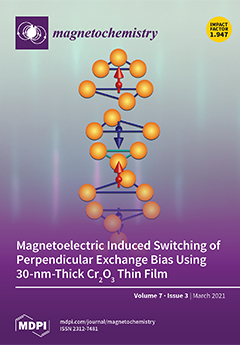Dinuclear and polymer complexes of 4-phenylpyridine (4-phpy), pyazine (pyz), and 4,4′-bipyridine (4,4′-bpy) were prepared by using
cis-[Rh
2(4-Me-pf)
2(O
2CR)
2] (4-Me-pf
- =
N,N’-bis(4-methylphenyl)formamidinate anion; R = CF
3 and CMe
3) as precursor dinuclear
[...] Read more.
Dinuclear and polymer complexes of 4-phenylpyridine (4-phpy), pyazine (pyz), and 4,4′-bipyridine (4,4′-bpy) were prepared by using
cis-[Rh
2(4-Me-pf)
2(O
2CR)
2] (4-Me-pf
- =
N,N’-bis(4-methylphenyl)formamidinate anion; R = CF
3 and CMe
3) as precursor dinuclear units. The dinuclear structures of
cis-[Rh
2II,II(4-Me-pf)
2(O
2CR)
2(4-phpy)
2] and
cis-[Rh
2II,III(4-Me-pf)
2(O
2CCMe
3)
2(4-phpy)
2]BF
4 and polymer structures of [Rh
2II,II(4-Me-pf)
2(O
2CR)
2(L)]
n (L = pyz and 4,4′-bpy) were confirmed by X-ray crystal structure analyses. In these complexes, the lantern-type dinuclear core structures with
cis-(2:2) arrangement of formamidinato (4-Me-pf
-) and carboxylato ligands are preserved with Rh–Rh distances of 2.44–2.47 Å, regardless of the difference in the axial ligand and oxidation state Rh
2II,II or Rh
2II,III. In the cyclic voltammograms (CVs) in CH
2Cl
2, the redox potentials for Rh
2II,III/Rh
2II,II were estimated as
E1/2 = 0.07 V and −0.28 V (vs. Fc
+/Fc) for
cis-[Rh
2(4-Me-pf)
2(O
2CCF
3)
2(4-phpy)
2] and
cis-[Rh
2(4-Me-pf)
2(O
2CCMe
3)
2(4-phpy)
2], respectively, negatively shifted by 0.16 and 0.12 V compared with those of corresponding parent dinuclear complexes. The results were interpreted that the axial interaction with 4-phpy ligands makes the Rh
2II,II core oxidized easily. The oxidized complex
cis-[Rh
2(4-Me-pf)
2(O
2CCMe
3)
2(4-phpy)
2]BF
4 is paramagnetic, which was confirmed by effective magnetic moment value
μeff = 1.90 μ
B at 300 K per Rh
2II,III unit (
S = 1/2). The polymer complexes [Rh
2(4-Me-pf)
2(O
2CR)
2(L)]
n (L = pyz and 4,4′-bpy) showed Type II gas-adsorption properties for N
2.
Full article





